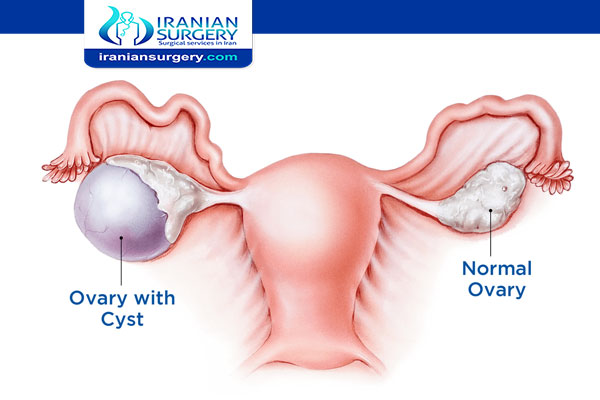What is the normal size of left and right ovary in MM?
what size of ovarian cyst is dangerous?
There are different types of ovarian cysts, each with unique causes and characteristics. The size of an ovarian cyst can also vary depending on what type of cyst it is.
There are two main types of ovarian cysts:
. Functional ovarian cysts – the most common type. These harmless cysts form part of the female’s normal menstrual cycle and are short-lived.
. Pathological cysts – these are cysts that grow in the ovaries; they may be harmless or cancerous (malignant).
Size is also one of several factors that can help determine whether a cyst needs to be surgically removed. Generally speaking, surgery isn’t recommended for ovarian cysts unless they’re larger than 50 to 60 millimeters (mm) (about 2 to 2.4 inches) in size.
However, this guideline can vary. For instance, a simple cyst may be left alone until it’s 10 cm (4 inches) in size. And cancerous cysts may be removed when they’re much smaller.
Read more about: surrogacy in iran
Read more about: egg donation cost in iran
Read more about : Ovarian Cyst Removal Surgery
Functional cysts

Functional cysts form when your menstrual cycle follows its normal pattern. In some cases, though, the cyst can continue growing. Two examples of functional cysts include the following:
. Follicular. Follicular cysts form when a follicle, a small sac that stores an egg and produces estrogen, doesn’t release the egg during ovulation. Instead, the follicle continues growing, producing a follicular cyst.
. Corpus luteum. Corpus luteum cysts can form when the empty follicle sac doesn’t shrink after ovulation. Instead, the sac becomes sealed off and starts to fill with fluid, leading to a corpus luteum cyst.
Most functional cysts are 2 to 5 centimeters (cm) (about 3/4 of an inch to 2 inches) in size. Ovulation happens when these cysts are around 2 to 3 cm in size. However, some may reach sizes of 8 to 12 cm (around 3 to 5 inches).
Read more about : Ovarian cancer treatment
Read more about : What is Lactate Dehydrogenase (LDH)?
Pathological cysts
There are two types of pathological cysts:
. Dermoid cysts
Dermoid cysts are also called teratomas. They can contain different types of tissue, such as skin, hair, and fat. Dermoid cysts are often asymptomatic, although they may cause symptoms and complications if they become large.
These cysts are actually a type of ovarian tumor. They’re almost always benign and are often present from birth. Dermoid cysts can grow during a woman’s reproductive years
These cysts often grow slowly, progressing at a rate of about 1.8 mm (about 0.07 inches) per year.
Dermoid cysts do have the potential to become large, though. Case studies have reported that some dermoid cysts can grow more rapidly, between 8 and 25 mm (0.3 to about 1 inch) per year.
In rare cases, giant dermoid cysts over 15 cm (about 6 inches) in diameter have been reported.
. Cystadenomas
Cystadenomas are benign tumors that develop on the surface of your ovaries. They can be filled with a watery or mucus-like liquid.
When viewed using ultrasound, a cystadenoma often looks like a functional cyst. However, while functional cysts typically go away after several menstrual cycles, a cystadenoma will continue to get bigger.
Cystadenomas can also become quite large. While some can be on the smaller side, around 1 to 3 cm (roughly half an inch to 1 inch), some can grow up to 30 cm (almost a foot).
Read more about : Ovarian cancer symptoms
Other cysts

. Endometriomas
Endometriomas form due to endometriosis. Endometriosis is a condition where the cells of the uterine lining grow outside of the uterus. This tissue can attach to the surface of your ovary and form a cyst.
It’s estimated that between 17 and 44 percent of women with endometriosis will have an endometrioma. These cysts are sometimes called chocolate cysts because they can contain thick, dark blood that gives them a brownish color.
Endometriomas are typically small, but like other cysts, they can come in a range of sizes.
What size of ovarian cyst is normal?
Sometimes the cyst can grow larger than the normal size which is up to 3 cm (a little over an inch). If the sac that holds the egg doesn’t break open to release the egg, it can grow, anywhere in size from ½ inch (1cm) to 4 inches (10cm) across. Most follicular cysts will disappear in 2-8 weeks and do not cause pain.
What size of ovarian cyst is dangerous?
Ovarian cysts may be classified according to whether they are a variant of the normal menstrual cycle, referred to as a functional or follicular cyst. Most ovarian cysts are small and harmless. They occur most frequently during the reproductive years, but they can appear at any age. There are often no signs or symptoms, but ovarian cysts can sometimes cause pain and bleeding. If the cyst is over 5 centimeters in diameter, it may need to be surgically.
What is the average size of an ovarian cyst?
There are different kinds of ovarian cysts. They can occur for various reasons, and they may need different treatments. A normal ovary is about 2 x 3 cm (almond sized). A follicular ovarian cyst, if the egg is not ejected and the amount of fluid continues to increase, can reach sizes of up to 10 cm. Fortunately most follicular cysts are smaller and will resolve within one to three months.


13 Responses
Hello There. I found your blog using msn. This is a really well written article.
I will be sure to bookmark it and come back to read more of your useful info.
Thanks for the post. I’ll certainly return.
my web page … Milagros
Good and correct information is an effective step in the health of humans. Thanks to all those who work for useful and correct information.
hello dear, thank you so much for your kind support.
My one ovary cyst size is 53*43 mm and other ovary cyst size is 53*51mm , what should I do? Surgery or doing treatment with english medicine?
It needs to be diagnosed by sono. the age of paitient and other history required.
Pls I need your help, I have cyst and am in pains.
It needs to be diagnosed by doctor.
what size of ovarian cyst is harmful?
Hey Jessica, Most ovarian cysts are small and harmless. They occur most frequently during the reproductive years, but they can appear at any age. There are often no signs or symptoms, but ovarian cysts can sometimes cause pain and bleeding. If the cyst is over 5 centimeters in diameter, it may need to be surgically removed
if you need more information feel free to Contact our medical team via What’s app +989019290946
Ovarian cyst rupture is dangerous
Hello. you should consult with your doctor if ovarian cyst rupture has happened to you.
in general Cysts can develop in response to a pelvic infection (called an abscess). If an infected cyst ruptures, it can trigger sepsis, a life-threatening immune response to harmful bacteria. Women with infected cysts are treated with antibiotics and sometimes require hospitalization for surgical drainage of the cyst.
hello doc. I’m. ciara 32 years. Old and have a 4 mm ovarian cyst left
I haven’t had the time. to. go to a gp and was wondering if you can help me with it
would you mind let me know what’s the normal size of ovarian cyst?
hello Ciara. First of all we suggest that you go to your GP as soon as possible.
secondly you have to consider that
Most functional cysts are 20 to 50 MM (about 3/4 of an inch to 2 inches) in size. Ovulation happens when these cysts are around 20 to 30 MM in size. However, some may reach sizes of 8 to 12 MM (around 3 to 5 inches)